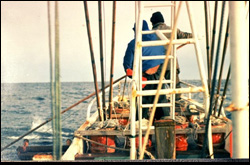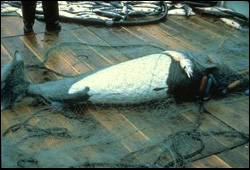Dall’s porpoise are the fastest of the small dolphins sometimes called porpoises. These strikingly-colored black-and-white dolphins are commonly seen off the cold-water coasts in the Pacific.
In 1982, Japan was driftnetting in US waters of the Bering Sea under US government permit. (We eventually dealt with that; see the Driftnet section). At that time, Japan was receiving annual US permits to kill Dall’s porpoise “incidentally” in their salmon driftnets, and were, additionally, refusing to keep dead ones for the National Marine Fisheries Service (NMFS) to autopsy. In fact, the scientific practices of Japan’s driftnetters were decidedly skewed: any dead dolphin the crew could shake out of their nets before it hit the decks of their ship was not counted as dead; and this was pretty much all of them.
Not to be outdone by the silliness of Japan’s dolphin-killing procedure, the US government decided that since Japan was not providing NMFS with dead dolphins to dissect, with which it could determine the impact of the fishery and make determinations on future permits; that NMFS would charter its own boat with US tax dollars to kill 963 Dalls’ porpoise in the Bering Sea. This would be done by jamming harpoons into their backs as they playfully came up to ride the bow wave of the “research” boat. These dolphins would be autopsied to determine the impact of Japan’s fishing fleet, which was, of course, entirely unrelated and killing dolphins in an entirely different way.
Greenpeace Foundation then-president Don White read of the proposed kill in the Federal Register, and interceded with GPUSA, (with which Greenpeace Foundation was then associated) to insert a card alerting the public into its ongoing multi-million piece mailouts. The resulting firestorm caused the US porpoise-harpooning cruise to be sacked.
Japan was at that time still being allowed “incidental” kills of Dall’s porpoise in U.S. waters. It was bad enough that Japan refused to supply honest counts of dead dolphins from its fishing, but the intent of the Marine Mammal Protection Act was being flouted as well. Far from doing everything possible to minimize the kill, Japan was intentionally killing large numbers of Dall’s porpoise in its own waters. Off-season swordfish boats from the ports of Yamada and Oozuchi on Japan’s Sanriku Coast were themselves harpooning dall’s porpoise as a way to keep the boats active in the seasonal absence of swordfish. Greenpeace Foundation took the position, in Don White’s discussions with the head of Japan’s Salmon Fisheries Cooperative, that to qualify for incidental kill permits in the lucrative salmon fishery, Japan should stop its intentional directed kills; and this well-publicized position highlighted the hypocisy of the U.S. and Japan on this issue. Greenpeace Foundation placed an undercover operative in 1985 who went to sea with the crew of a harpooning vessel to document the dall’s porpoise kill with facts and photos which are still relevant today.
A year after the ’83 Greenpeace Foundation/GPINTL Bering Sea driftnet campaign, Japan was excluded from driftnet fishing in US waters. In 1984, WTBS aired internationally the 60-minute special production “From No Man’s Land a Porpoise Cries”, produced under contract with Greenpeace Foundation with content by White. In 1990 Japan, along with the rest of the world, ended pelagic driftnetting in international waters when the organization Earthtrust finished the campaign started by Greenpeace Foundation, removing the walls of death from the migratory paths of these dolphins.
Dall’s porpoise, or “ishi iruka” as it is known in Japan, is now often showing up mislabeled as whale meat and thus fetching a high price within Japan. Until this mislabeling can be stopped, dall’s porpoise will continue to die by the thousands. As the organization which has usually led the fight on their behalf, Greenpeace Foundation will continue to stand by these beautiful, agile mariners.
The USA’s oldest and original Greenpeace, proudly unaffiliated with Greenpeace USA




